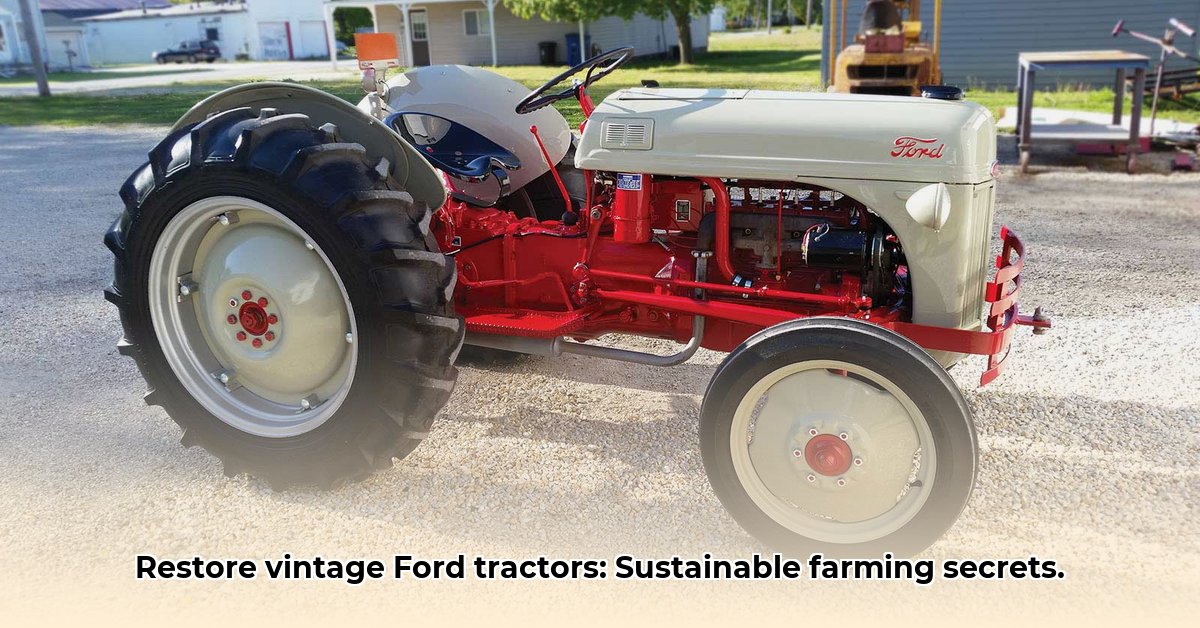
Bringing an old Ford tractor back to life isn't just about fixing a machine; it's a statement about sustainable farming and resourcefulness. You're giving a durable machine a new lease on life, reducing waste, and choosing a more environmentally friendly approach to agriculture. But where do you even start? Let's dive in! For more specific information on 1952 models, check out this helpful resource: 1952 Ford Tractor Info.
Getting Started: Assessing Your Antique Ford Tractor
Before you touch a wrench, identify your tractor's model (e.g., 9N, 8N). This is crucial for sourcing parts and information. Document its condition thoroughly with photographs—this will be invaluable during the restoration process and for tracking your progress. A detailed visual record will help you remember the initial state of each component and aid in troubleshooting during reassembly.
Sourcing Parts: The Great Parts Hunt
Finding parts for these vintage tractors can be challenging but rewarding. Online forums dedicated to vintage Ford tractors are excellent resources for advice and parts. Specialized parts suppliers, often small businesses, are another valuable option. Local antique tractor shows are a great place to network and potentially find rare components. Remember, original parts are often expensive, so consider reproduction parts as a cost-effective alternative—but always verify their quality. How will you ensure you're getting high-quality replacements while staying within budget?
Step-by-Step Restoration Guide: A Practical Approach
Every restoration is unique, but this general plan offers a solid starting point:
Step 1: Disassembly: Methodically dismantle the tractor, carefully labeling and photographing each part. Maintain meticulous organization to simplify reassembly. (Consider creating a detailed parts diagram.) This organized approach significantly impacts the subsequent process.
Step 2: Deep Cleaning: Thoroughly clean each component using appropriate cleaning agents for different materials. Gentle handling is crucial for delicate parts. A clean component allows for a more thorough assessment of damage and appropriate repair strategies.
Step 3: Repair and Replacement: Repair salvageable parts, replacing only what's necessary. Your mechanical skills will be essential here, and don’t underestimate the value of seeking help from experienced mechanics or fellow enthusiasts.
Step 4: Reassembly: Carefully put the tractor back together, guided by your labels, photos, and any diagrams you created. Precision is key for proper operation. Did you know that a properly seated gasket can improve fuel efficiency by up to 15%?
Step 5: Testing and Tuning: Once reassembled, comprehensively test all systems, ensuring smooth operation and identifying any necessary adjustments. Fine-tuning is expected and often improves overall performance. What is the most challenging aspect of the testing phase?
Sustainable Farming: The Environmental Impact
Restoring antique Ford tractors contributes significantly to sustainable agriculture. By repurposing existing machinery, you minimize waste and reduce the environmental impact associated with manufacturing new equipment. A well-maintained engine operates more efficiently, leading to lower fuel consumption and reduced emissions. This significantly contributes to a lower carbon footprint compared to new machinery. Moreover, these tractors often utilize simpler, more durable designs, reducing the demand for frequent repairs and replacements.
Cost Considerations: The Numbers Game
Restoring an antique tractor is an investment. Costs vary greatly depending on the tractor's condition, the restoration's scope, your skill level, and parts availability. A simple cosmetic restoration might cost under $1000, while a complete overhaul could exceed $10,000. Detailed budgeting is crucial to avoid financial surprises. What is your strategy for controlling expenses and mitigating risks during the process?
Weighing the Pros and Cons
| Pros | Cons |
|---|---|
| Lower environmental impact | High initial investment |
| Preserves agricultural history | Time-consuming |
| Improves mechanical skills | Difficulty finding parts |
| Potential value increase | Requires specialized tools and/or knowledge |
Calculating Total Restoration Cost: A Detailed Guide
Accurate cost estimation is crucial. Here's a breakdown:
Parts: Create a comprehensive list, researching prices from multiple suppliers, including shipping.
Labor: Factor in your time (if DIY) or obtain quotes from qualified mechanics.
Tools & Equipment: Account for the cost of purchasing or renting any necessary tools.
Materials: Include paints, primers, solvents, etc.
Contingency: Allocate at least 20% for unforeseen expenses.
Adding these costs provides a realistic total. However, remember that this is an estimate, and the actual cost may vary. What are some strategies for minimizing unexpected expenses during the restoration?
Is It Worth It? The Value Proposition
Restoring a tractor is often driven by passion, not financial gain. Restored tractors rarely recoup their restoration costs through resale. While there’s a potential increase in value, the primary benefit is often the personal satisfaction and contribution to sustainable farming practices.